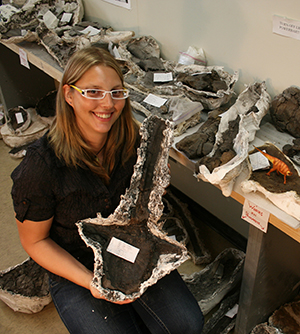’17 MSc
 Katherine researched hadrosaurid dinosaurs for her MSc studies. Hadrosaurs were abundant megaherbivores that used highly specialized dental batteries for grinding vegetation. These dental batteries can have up to 60 rows of teeth, each row known as a tooth family. The tooth families sit inside grooves called alveoli. The aim of this research was to determine how new alveoli form in the hadrosaur dentary as the dinosaur grows, and how new tooth families fill these alveoli. There are two subfamilies in Hadrosauridae, Hadrosaurinae and Lambeosaurinae, each having distinct tooth and dentary morphologies when they are mature. Taking this into consideration, comparisons of how the alveoli and tooth families form, and at what growth stage, should reveal differences as these subfamilies develop distinct dentitions.
Katherine researched hadrosaurid dinosaurs for her MSc studies. Hadrosaurs were abundant megaherbivores that used highly specialized dental batteries for grinding vegetation. These dental batteries can have up to 60 rows of teeth, each row known as a tooth family. The tooth families sit inside grooves called alveoli. The aim of this research was to determine how new alveoli form in the hadrosaur dentary as the dinosaur grows, and how new tooth families fill these alveoli. There are two subfamilies in Hadrosauridae, Hadrosaurinae and Lambeosaurinae, each having distinct tooth and dentary morphologies when they are mature. Taking this into consideration, comparisons of how the alveoli and tooth families form, and at what growth stage, should reveal differences as these subfamilies develop distinct dentitions.
Katherine is from New Brunswick, where she completed her first undergraduate degree at University of New Brunswick. She came to Alberta to complete a second undergraduate degree, a BSc with Honors in Paleontology in 2014. Her BSc research included digitally mapping a dinosaur bonebed in Edmonton, studying the facial integument of ankylosaurs, and interpreting Alberta microsite material. Her undergrad honors thesis revolved around the holotype skull of Corythosaurus excavatus, a hadrosaurid collected in 1920, and determining whether or not postcranial material found in 1992 belonged to it. Katherine received a MSc with Specialization in Systematics and Evolution in 2017 and then began working in the Quaternary Palaeontology department of the Royal Alberta Museum.
LAB-RELATED PUBLICATIONS
Bramble, K., LeBlanc, A.R.H., Lamoureux, D.O., Wosik, M., and Currie, P.J. 2017. Histological evidence for a dynamic dental battery in hadrosaurid dinosaurs. Scientific Reports 7:15787. DOI: 10.1038/s41598-017-16056-3
Bramble, K., Currie, P.J., Tanke, D.H., and Torices, A. 2017. Reuniting the “head hunted” Corythosaurus excavatus (Dinosauria: Hadrosauridae) holotype skull with its dentary and postcranium. Cretaceous Research 76: 7–18. DOI: 10.1016/j.cretres.2017.04.006
Bramble, K., Burns, M.E., and Currie, P.J. 2014. Enhancing bonebed mapping with GIS technology using the Danek Bonebed (Upper Cretaceous Horseshoe Canyon Formation, Edmonton, Alberta, Canada) as a case study. Canadian Journal of Earth Sciences 51: 987–991. DOI: 10.1139/cjes-2014-0056
Bramble, K.K. 2017. A Histological Analysis of the Hadrosaurid Dental Battery [master’s thesis]. University of Alberta Education and Research Archive. DOI: 10.7939/R3ST7FB18
OTHER LINKS



